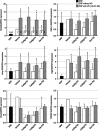Effect of a magnesium-based phosphate binder on medial calcification in a rat model of uremia
- PMID: 23486515
- PMCID: PMC3674404
- DOI: 10.1038/ki.2013.34
Effect of a magnesium-based phosphate binder on medial calcification in a rat model of uremia
Abstract
Calcium-based phosphate binders are used to control hyperphosphatemia; however, they promote hypercalcemia and may accelerate aortic calcification. Here we compared the effect of a phosphate binder containing calcium acetate and magnesium carbonate (CaMg) to that of sevelamer carbonate on the development of medial calcification in rats with chronic renal failure induced by an adenine diet for 4 weeks. After 1 week, rats with chronic renal failure were treated with vehicle, 375 or 750 mg/kg CaMg, or 750 mg/kg sevelamer by daily gavage for 5 weeks. Renal function was significantly impaired in all groups. Vehicle-treated rats with chronic renal failure developed severe hyperphosphatemia, but this was controlled in treated groups, particularly by CaMg. Neither CaMg nor sevelamer increased serum calcium ion levels. Induction of chronic renal failure significantly increased serum PTH, dose-dependently prevented by CaMg but not sevelamer. The aortic calcium content was significantly reduced by CaMg but not by sevelamer. The percent calcified area of the aorta was significantly lower than vehicle-treated animals for all three groups. The presence of aortic calcification was associated with increased sox9, bmp-2, and matrix gla protein expression, but this did not differ in the treatment groups. Calcium content in the carotid artery was lower with sevelamer than with CaMg but that in the femoral artery did not differ between groups. Thus, treatment with either CaMg or sevelamer effectively controlled serum phosphate levels in CRF rats and reduced aortic calcification.
Figures





References
-
- Guérin AP, London GM, Marchais SJ, et al. Arterial stiffening and vascular calcifications in end-stage renal disease. Nephrol Dial Transplant. 2000;15:1014–1021. - PubMed
-
- Qunibi WY, Nolan CA, Ayus JC. Cardiovascular calcification in patients with end-stage renal disease: a century-old phenomenon. Kidney Int. 2002;62:S73–S80. - PubMed
-
- Phan O, Ivanovski O, Nokolov IG, et al. Effect of oral calcium carbonate on aortic calcification in apolipoprotein E-deficient (apoE-/-) mice with chronic renal failure. Nephrol Dial Transplant. 2008;23:82–90. - PubMed
-
- Chertow GM, Raggi P, McCarthy JT, et al. The effects of sevelamer and calcium acetate on proxies of atherosclerotic and arteriosclerotic vascular disease in hemodialysis patients. Am J Nephrol. 2003;23:307–314. - PubMed
Publication types
MeSH terms
Substances
LinkOut - more resources
Full Text Sources
Other Literature Sources
Medical
Research Materials

